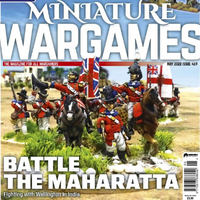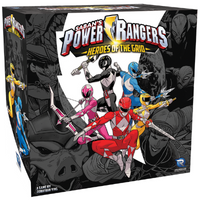08 July 2022
|
A descent on the French Coast
In a previous months issue I produced a photo report of Partizan 2021 and – while there were many fine games at the show – one caught many a gamers' eye to the extent that it won a Best of Show award – and rightly so. As your intrepid reporter, I spoke to the folks behind it – the Friends of a Military Gentleman – but specifically Graham Hilditch. I asked Graham to give me some details of the phenomenal effort and he kindly agreed to do so meaning I could include a few more snaps of their gorgeous game. So – without further ado – over to you Mr Hilditch! Ed.
GRAHAM’S TALE
The game was put on by me and ably supported by Stuart Insch. In the build for the game I built and painted all of the figures and scenery. We had travelled for eight hours by van to get to the show in Newark. I hail from Forres, near Inverness and Stuart lives near Aberdeen.
I have been a wargamer for more years than I like to remember however I have never put on a display (I found this astonishing! Ed.), but it was on my bucket list of things to do. The idea originated some years ago, after I had purchased the fabulous book by John Ray called A Military Gentleman.
The photographs in his book were superb, and I had never seen such a standard of workmanship and quality presentation. The scenes were awe inspiring, and I decided to up my game and try and emulate his collection. I had several conversations with Ray, and my first lesson was to focus on one period. I chose The Seven Years War.

BACKGROUND
During The Seven Years’ war Britain contributed cash to its continental allies but never quite had the manpower in its standing army to be able to field large numbers of men. Instead, it provided the coin and contingents to fight alongside its friends. However, there were a number of times when it was felt that a “descent” on the French Coast or on French or Spanish colonial possessions was a worthwhile effort, often because there was some “prize” worth grabbing!
Rochefort, Cherbourg, St Malo and St Cast in France, Louisbourg in Canada and Havana on Cuba are all prime examples of this type of warfare. Initially the operations were poorly planned and organised. There were long periods spent mustering troops and vessels in ports where spies brought back word that something was afoot and sometimes even details of the ships, units, and destination.
The next issue was how to get the men ashore. Warships would come in close to the coast and try to remain on station through tide and wind changes while troops ships lowered longboats and men boarded and rowed to an assembly area before heading for the beach at a given signal. The men were horribly vulnerable to waves and shot from the shore and could not return fire themselves, trusting the Royal Navy to protect them. A warship, despite mounting many guns is at a disadvantage to a shore battery or fort. The ship moves, while the latter is stationary. A fort can often mount larger calibre guns and offers stout protection of walls and thick embankments.
Assault landings made use of innovations such as special flat bottomed landing boats and troops trained to land and deploy from them, such as those taken to Cuba in 1762. Flag signals were used to communicate between the landing boats, men ashore and the navy and when surprise was achieved the result could be an army delivered efficiently to the beach in overwhelming numbers ready to take the bayonet to a surprised and wrong-footed foe, scrambling to regain the initiative.
The scenario we wanted to produce for Partizan shows all the elements of a large scale descent.
Two large warships stand off and are battering the coast defences which are attempting to respond. Boatloads of troops are landing on the beach. The army has established siege lines and is attempting to take the town, but reinforcements are on their way from the neighbouring area. Meanwhile in the town itself some of its citizens are trying to go about their business as usual and while others cower in despair at the destruction others are drawn to the spectacle as if it were some grand sporting event.

FIGURES
I went for 40mm scale because I wanted something unique, like A Military Gentleman, I was worried that my eyes were deteriorating, and that it would be easier to paint in a larger such as 40mm scale. How wrong I was! I decided to have all of my regiments in marching pose, to create long even lines of troops, very much after the style of the period. Officers and vignettes would be individually made, and these would give some variety from the marching lines. I went for big regiments: each unit has 36 figures, plus two officers and an NCO. I knew that this would be a long term project given the number of regiments that I wanted to produce, and the scale involved.
When it came to figure choice, I went for the Sash and Sabre line: I felt they had character, were convertible, and were reasonably priced for a 40mm figure. The incomparable Mark Allan, painted most of my flags: they are miniature works of art in their own right, and professional painter Dave Jarvis painted one figure for each unit which enabled me to re-produce his style.
STARTING TO PAINT
For the next few years I painted away, creating many regiments and various nations. I was lucky in that I had just retired, but was still being paid for two years as part of a buy-out. This allowed me to devote many hours to the hobby, without having to work for a living. I now have major armies for Prussia, Austria, France and Britain, plus a number of smaller nations such as Saxony, Hanover etc.
BRING IN THE NAVY
In 2019 Stuart Insch spotted some wonderful ships in a local antique shop. The quality was superb and I decided I had to have some, although I had no idea what to use them for! Fortunately the ships had been in the shop for some time, and the dealer gave me an excellent price for purchasing two of them. It was at this point I decided to create a British naval action as my show game, including a beach, rowing boats and a landing party attacking a French coastal battery.

PRINTING
I purchased a Prusa 3D printer, using PLA to print the rowing boats and coastal battery. The setup was good, but not big enough. I then added a 3D printed Vauban fort in 40mm, which took nearly three months just to print! To this was added a siege and entrenchment scene, with the British and Hanoverians, attacking the French fort. The finished model looked good, but the far end of the display seemed bare. I then added a French town which I again constructed using my Prusa 3D printer. Most of the houses come in four sections, and even the interiors are detailed. They do take some time and patience to paint!
VILLAGE FOLK
Lastly, the village was populated, mainly using my own converted 40mm figures as well as some Edward Suren and Ratkin 30mm. The difference scale was not really noticeable (and – after all – perhaps most poorly fed peasants would be shorter than fighting men? Ed.). The Ratkins are a new range, sold by Graham Cumming, ex-proprietor of Crann Tara figures. They are one of the best series of civilians I have ever seen, with lots of detail and personality and are a joy to paint. There are currently two sets of ten figures on the market, with another eight sets due to come out, including a sedan chair. Suren figures are now over half a century old, but still stand the mark of time. The market place feature was another 3D download which I printed out, as were the carts, fountains and other features.
HEARTS OF OAK
One of the major problems with the display was how to show the ships. They were bought as display pieces, mounted on plinths, and I did not dare cut them to waterline level in case they collapsed. The answer was to purchase 2 metre x 1 metre x 50mm deep polystyrene insulation boards from a local hardware store. A slot was cut to sink in the boats to hull level, and I then used Polyfilla and PLA to create the waves around the boats. This was painted various shades of dark blue and black, then satin varnished. Too often, people make the mistake of making water far too blue. The sea looks nearly black in real life.
The insulation boards were ideal for the boats, but it also meant that the rest of the display would have to be raised so that it appeared above sea level. Back to the hardware shop and two or three insulation boards were placed on top of each other to a maximum height of 150mm to complete the display. The boards were textured with Polyfilla, coated with PLA and then painted and finished with various scatters.

DEEP CUT
The raised boards were useful when it came to building the entrenching scene, as we could now create real trenches 50mm deep. In retrospect – although raising the display took up additional space – I think that it stood out on the day from other displays which were at table level. The final display measured 18ft x 6ft and I only saw it complete for the first time on the day of the show: it had just been too large to lay-out at home!
Altogether, the project took about 2 to 2.5 years to finish, early retirement and Covid lockdown, greatly assisting in completing the project. This was to be a “one-off” “never again” project, but I enjoyed Partizan so much, and the response from visitors and traders was so enthusiastic and positive, that who knows: I may return with another effort.
Looking for more?

This scenario was one of many that appears in Miniature Wargames Magazine, our monthly publication for all kinds of wargames! You can check out our latest issue, or previous issues by clicking here
Get your magazine hereOne Day, One Whole Army...

If you have a stack of miniatures in need of painting, preventing you from bringing anything new to the table, check out this article, where we hear from a contributor who managed to paint an entire army in a single day!
Get your paint on!
Join us in person

We can't wait for Tabletop Gaming Live 2022! An epic weekend in Manchester full of board games, card games, roleplaying games, wargames and more, with amazing exhibitors, great games, and an opportunity to game together in person.
See you there!Treat Yourself!

Have you visited our game store? We have everything from mystery boxes, to games and accessories – including the above Power Rangers: Heroes of the Grid, with a great discount! Head over to find your new favourite game.
Visit the Game Store
Sometimes we may include links to online retailers, from which we might receive a commission if you make a purchase. Affiliate links do not influence editorial coverage and will only be used when covering relevant products








Comments
Login or register to add a comment
No comments